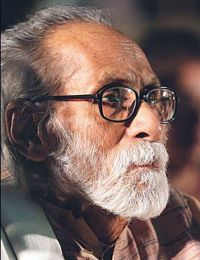Huq, Amanul

Huq, Amanul (1925-2013) Photographer. He played an important role during the Language Movement by photographing events of the Language Movement and specially one of its heroes, Shaheed Rafiquddin. Amanul Huq was born on 6 November 1925 in an enlightened family of Shahjadpur upazila of Sirajganj district. His father’s name is Dr. Abdul Huq, mother Hajera Khatun. Amanul Huq passed Matriculation in 1943 and got admitted into Intermediate Edward College, Pabna. However, he could not pursue his studies due to physical fitness. Although he was admitted to Art College in Dhaka, he had to stop his studies soon. Inspired by his father, Amanul Huq was attracted to painting and photography since boyhood. At a young age, his photographs were published in various periodicals of Calcutta and received high praise.
Although he did not complete his art college studies, Amanul Huq joined Dhaka Medical College as an artist-cum-photographer. He used to give pictures of different parts of the human body to the medical students. While in service, he was involved in the language movement of 1952. During the movement on 21 February 1952, photographer Amanul Huq took the documentary picture of Shaheed Rafiq, whose skull was blown off by police firing. A copy of this picture was sent to Dainik Azad for printing, but it was not printed there. When students brought out leaflets using the same image and distributed it, the police confiscated those leaflets and banned the image, while tracking down Amanul Huq.
Amanul Huq became widely known by photographing various episodes of the Language Movement of 1952. In the 1954 United Front elections, Amanul Huq’s photograph of Shaheed Rafiq was used in posters to stir up public outrage against the ruling Muslim League. After the victory of the United Front in the elections, a large-scale cultural festival and literary conference was organized in Dhaka. There Amanul Huq organized an exhibition titled ‘Amar Desh’ with 100 photographs taken by himself covering Language Movement and martyrs. Tarashankar Bandopadhyay, Subhash Mukhopadhyay, Manoj Bose, who came from other parts of Bengal in India to attend the literary conference, highly praised Amanul’s skill in photography.
In the aftermath of the language movement the police started a massive round of arrests. Amanul Huq resigned from his job in Dhaka Medical College and crossed the border into Kolkata to avoid arrest. There he met with the world famous filmmaker Satyajit Roy through Subhash Mukhopadhyay. Amanul Huq gradually became Satyajit Ray’s photographer friend. He captured the creative moments of Satyajit Ray’s famous movies including Pather Panchali, Devi and Tin Kanya. Satyajit Roy later wrote about Amanul Huq’s work - ‘For more than a generation, Amanul has left a deep love for the overall expression of Bengali life and culture by thoroughly depicting every aspect of the lifestyle of his own country.’
After a decade, Amanul Huq returned to the country for love of the motherland. By then, he enriched himself with lot of experiences. He continued to take pictures in the streets and in different corners of Bangladesh. His loved motherland kept coming into the frame of his camera. The moving event he captured included the 1969 mass uprising, Bangabandhu’s seventh march address, mass-killing by Pakistani forces on 25 March 1971 and the the Liberation War. Amanul Huq was very close to Bangabandhu Sheikh Mujibur Rahman and Tajuddin Ahmad. He captured many of their pictures on camera. Maulana Bhasani called him an artist.
After the recognition of Ekushey February by the UNESCO as the ‘international mother language day’, he wrote Ekushey Tamsuk (2003) and Bangla Souvenir (2004), the fruits of his laborious thinking, to introduce the Bengali language, traditions and history of Ekushey February to the expatriate Bengali families and the new generation. On Satyajit Ray, he wrote Prashanga Satyajit (2010). Besides these, he released Swadesher Mukh (2013), Smritichitra (2016), Amar Desh albums. Amanul Huq’s photographs are featured in the biography of Satyajit Ray authored by an internationally renowned filmmaker Mary Sitan. In the fifties of the twentieth century, Amanul Huq’s photograph, earned fame in the UNESCO World Exhibition of Photography and one of the photographs was included in the collection of World’s Best Photography. Amanul’s pictures were displayed in the international exhibition organized by the Royal Photographic Society on the occasion of Germany’s PHOTOKONA festival and were published in foreign newspapers.
During the Awami League government in 1956, the Prime Minister of China Chou En Lai visited East Pakistan (now Bangladesh). He was accorded citizens’ reception in Paltan ground, where the Chief Minister Ataur Rahman presented Amanul Huq’s album ‘Amar Desh Chitramala’ to the Chinese premier. In post-independence Bangladesh, Bangabandhu Sheikh Mujibur Rahman gave an album of ‘Amar Desh Chitramala’ as a personal gift to the visiting Indian Prime Minister Indira Gandhi. On the occasion of the first ‘International Mother Language Day’, Amanul Huq, the photographer of ‘Amar Desh Chitramala’, was conferred the ‘Language Soldier Award and Commemorative Crest’ by the National Museum for his overall contribution to the Language Movement. Amanul Huq was awarded with ‘Janakantha Pratibha Padak’ for his special contribution in the fields of photography, culture and photojournalism. Amanul Huq, the highest honorary fellow of Bangladesh Photographic Society, was awarded in the presence of world-renowned photographers with a felicitation at a photo exhibition organized by DRIK on behalf of the Prince Claus of the Netherlands Foundation. In 2009, Amanul Huq received the honorary fellowship of Bangla Academy.
The famous photographer abd Bhasha Sainik Amanul Huq was awarded the ‘Ekushey Padak’ by the Government of Bangladesh in 2011. He donated the gold medal and certificate signed by Prime Minister Sheikh Hasina to the Liberation War Museum. Amanul Huq was single in his personal life.
He passed away on 3 April 2013 at the age of 88. [Maniruzzaman Shahin]
